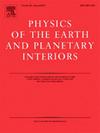Physics-informed neural networks for the improvement of platform magnetometer measurements
IF 1.9
3区 地球科学
Q2 GEOCHEMISTRY & GEOPHYSICS
引用次数: 0
Abstract
High-precision space-based measurements of the Earth's magnetic field with a good spatiotemporal coverage are needed to analyze the complex system of our surrounding geomagnetic field. Dedicated magnetic field satellite missions like the Swarm mission form the backbone of research, providing high-precision data with limited coverage. Many satellites carry so-called platform magnetometers that are part of their attitude and orbit control systems. These can be re-calibrated by considering different behaviors of the satellite system, hence reducing their relatively high initial noise originating from their rough calibration. These platform magnetometer data obtained from satellite missions not dedicated to geomagnetic fields complement high-precision data from the Swarm mission by additional coverage in space, time, and magnetic local times. In this work, we present an extension to a previous machine learning approach for automatic in-situ calibration of platform magnetometers. We introduce a new physics-informed layer incorporating the Biot-Savart formula for dipoles that can efficiently correct artificial disturbances due to electric current-induced magnetic fields evoked by the satellite itself. We demonstrate how magnetic dipoles can be co-estimated in a neural network for the calibration of platform magnetometers and thus enhance the machine learning-based approach to follow known physical principles. Here, we describe the derivation and assessment of re-calibrated datasets for two satellite missions, GOCE and GRACE-FO, which are made publicly available. Compared to the reference model, we achieved an average residual of about 7 nT for the GOCE mission and 4 nT for the GRACE-FO mission across all three components combined in the low- and mid-latitudes.

用于改进平台磁力计测量的物理信息神经网络
为了分析我们周围复杂的地磁场系统,需要高精度、具有良好时空覆盖的天基地磁场测量。像蜂群任务这样的专用磁场卫星任务构成了研究的支柱,在有限的覆盖范围内提供高精度数据。许多卫星携带所谓的平台磁力计,这是其姿态和轨道控制系统的一部分。这些可以通过考虑卫星系统的不同行为来重新校准,从而降低它们由于粗糙校准而产生的相对较高的初始噪声。这些从卫星任务中获得的平台磁力计数据不是专门用于地磁场的,通过在空间、时间和磁地方时的额外覆盖,补充了Swarm任务的高精度数据。在这项工作中,我们提出了一种扩展以前的机器学习方法,用于平台磁力计的自动原位校准。我们引入了一个新的物理信息层,该层结合了偶极子的Biot-Savart公式,可以有效地纠正由卫星本身引起的电流感应磁场引起的人为干扰。我们演示了磁偶极子如何在用于校准平台磁力计的神经网络中进行共估计,从而增强了基于机器学习的方法,以遵循已知的物理原理。在这里,我们描述了GOCE和GRACE-FO两个卫星任务的重新校准数据集的推导和评估,这些数据集是公开提供的。与参考模型相比,在低纬度和中纬度地区,我们获得了GOCE任务的平均残差约为7 nT, GRACE-FO任务的平均残差约为4 nT。
本文章由计算机程序翻译,如有差异,请以英文原文为准。
求助全文
约1分钟内获得全文
求助全文
来源期刊

Physics of the Earth and Planetary Interiors
地学天文-地球化学与地球物理
CiteScore
5.00
自引率
4.30%
发文量
78
审稿时长
18.5 weeks
期刊介绍:
Launched in 1968 to fill the need for an international journal in the field of planetary physics, geodesy and geophysics, Physics of the Earth and Planetary Interiors has now grown to become important reading matter for all geophysicists. It is the only journal to be entirely devoted to the physical and chemical processes of planetary interiors.
Original research papers, review articles, short communications and book reviews are all published on a regular basis; and from time to time special issues of the journal are devoted to the publication of the proceedings of symposia and congresses which the editors feel will be of particular interest to the reader.
 求助内容:
求助内容: 应助结果提醒方式:
应助结果提醒方式:


